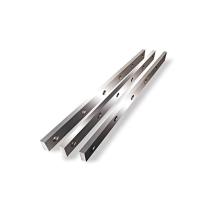D2 610mm Length Industry Round Cutting Blade For Printing Packaging
Description:
Here are some specific recommendations for blade geometry design
based on common cutting materials and processes:
1,Cutting soft materials (e.g., plastics, rubber, thin metals):
- Choose flat or slightly convex blade edge design
- Tooth pattern can be standard straight or serrated
- Blade material can be high-speed steel or coated high-speed steel
2,Cutting medium-hardness materials (e.g., medium carbon steel,
aluminum alloys):
- Choose slightly convex or R-type blade edge design
- Tooth pattern can be helical or wave-like
- Blade material can be tungsten carbide or coated diamond
3,Cutting hard materials (e.g., stainless steel, alloy steels):
- Choose R-type or concave blade edge design
- Tooth pattern is best suited for helical or pyramidal shape
- Blade material should be coated diamond or ceramic
4,Cutting highly ductile materials (e.g., thick metal plates,
composite materials):
- Choose saw-tooth or perforated blade edge design
- Tooth pattern can be helical or pyramidal
- Blade material should be coated diamond or ceramic
5,For high-speed cutting processes:
- Select blade materials with good thermal conductivity
- Adopt blade designs with cooling channels at the tip
- Tooth pattern can have a specialized angled geometry to reduce
vibration
Industrial Blade Specifications:
| Product name | Industry Round Cutting Blade |
| Material | D2 |
| Hardness | HRC52-80 |
| Precision | ±50 Micron |
| Length | 610mm |
| Width | 55mm |
| Thickness | 0.5mm |
| Applicable Industries | Manufacturing Plant |
When selecting the optimal tooth pattern for your cutting
requirements, there are several key factors to consider:
1,Material hardness and toughness:
- Softer materials generally work better with straight or serrated
tooth patterns to avoid excessive deformation.
- Harder materials benefit from angled or hooked tooth patterns that
can better fracture the material.
- Highly ductile materials may require specialized tooth designs like
saw-tooth or pyramidal patterns to prevent material buildup.
2,Cutting speed and feed rate:
- High-speed cutting often performs better with angled or wave-like
tooth patterns to reduce vibration and chatter.
- Lower speeds may allow simpler straight-edged teeth, but higher
feeds may necessitate more aggressive patterns.
3,Part geometry and accessibility:
- Complex or hard-to-reach workpiece shapes may require specialized
tooth designs for effective cutting.
- Internal cuts or tight clearances may favor tooth patterns that can
navigate tight spaces.
4,Noise and surface finish requirements:
- Smoother finishes are generally achieved with finer-pitched, more
numerous teeth.
- Coarser tooth patterns produce a rougher surface finish but may be
preferred for rapid material removal.
- Noise generation during cutting can be minimized by using angled or
serrated tooth profiles.
5,Tool life and maintenance:
- More aggressive tooth geometries tend to wear faster and require
more frequent resharpening.
- Compromise may be needed between cutting performance and tool
longevity.
Picture:

Size:

Applications:

Packing:










